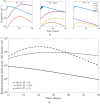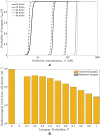Timescales modulate optimal lysis-lysogeny decision switches and near-term phage reproduction
- PMID: 35615104
- PMCID: PMC9126285
- DOI: 10.1093/ve/veac037
Timescales modulate optimal lysis-lysogeny decision switches and near-term phage reproduction
Abstract
Temperate phage can initiate lysis or lysogeny after infecting a bacterial host. The genetic switch between lysis and lysogeny is mediated by phage regulatory genes as well as host and environmental factors. Recently, a new class of decision switches was identified in phage of the SPbeta group, mediated by the extracellular release of small, phage-encoded peptides termed arbitrium. Arbitrium peptides can be taken up by bacteria prior to infection, modulating the decision switch in the event of a subsequent phage infection. Increasing the concentration of arbitrium increases the chance that a phage infection will lead to lysogeny, rather than lysis. Although prior work has centered on the molecular mechanisms of arbitrium-induced switching, here we focus on how selective pressures impact the benefits of plasticity in switching responses. In this work, we examine the possible advantages of near-term adaptation of communication-based decision switches used by the SPbeta-like group. We combine a nonlinear population model with a control-theoretic approach to evaluate the relationship between a putative phage reaction norm (i.e. the probability of lysogeny as a function of arbitrium) and the extent of phage reproduction at a near-term time horizon. We measure phage reproduction in terms of a cellular-level metric previously shown to enable comparisons of near-term phage fitness across a continuum from lysis to latency. We show the adaptive potential of communication-based lysis-lysogeny responses and find that optimal switching between lysis and lysogeny increases the near-term phage reproduction compared to fixed responses, further supporting both molecular- and model-based analyses of the putative benefits of this class of decision switches. We further find that plastic responses are robust to the inclusion of cellular-level stochasticity, variation in life history traits, and variation in resource availability. These findings provide further support to explore the long-term evolution of plastic decision systems mediated by extracellular decision-signaling molecules and the feedback between phage reaction norms and ecological context.
Keywords: control theory; evolution; mathematical modeling; viral ecology.
© The Author(s) 2022. Published by Oxford University Press.
Figures











References
-
- Aframian N. et al. (2022) ‘Dormant Phages Communicate via Arbitrium to Control Exit from Lysogeny’, Nature Microbiology, 7: 145–53. - PubMed
-
- Armijo L. (1966) ‘Minimization of Functions having Lipschitz Continuous First Partial Derivatives’, Pacific Journal of Mathematics, 16: 1–3. doi: 10.2140/pjm.1966.16.1 - DOI
Grants and funding
LinkOut - more resources
Full Text Sources

